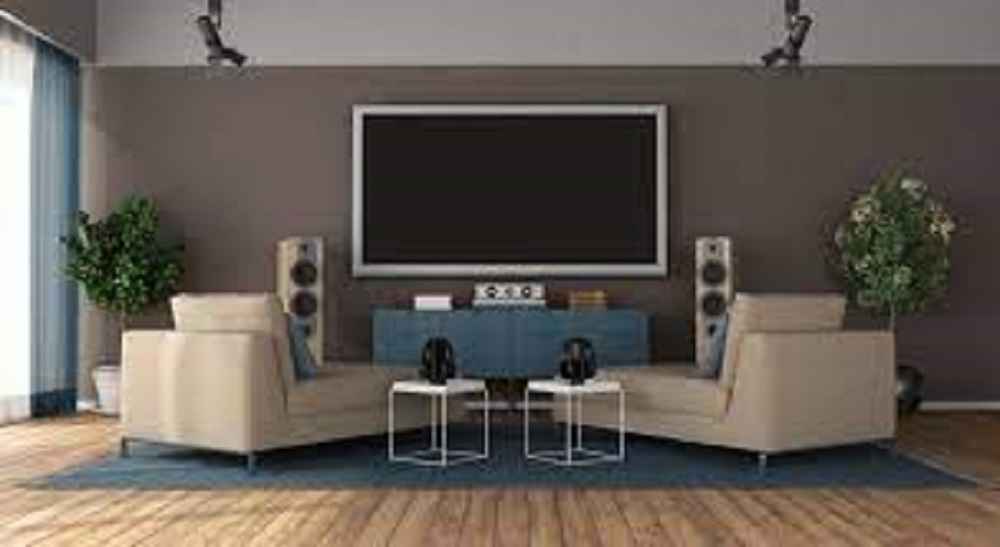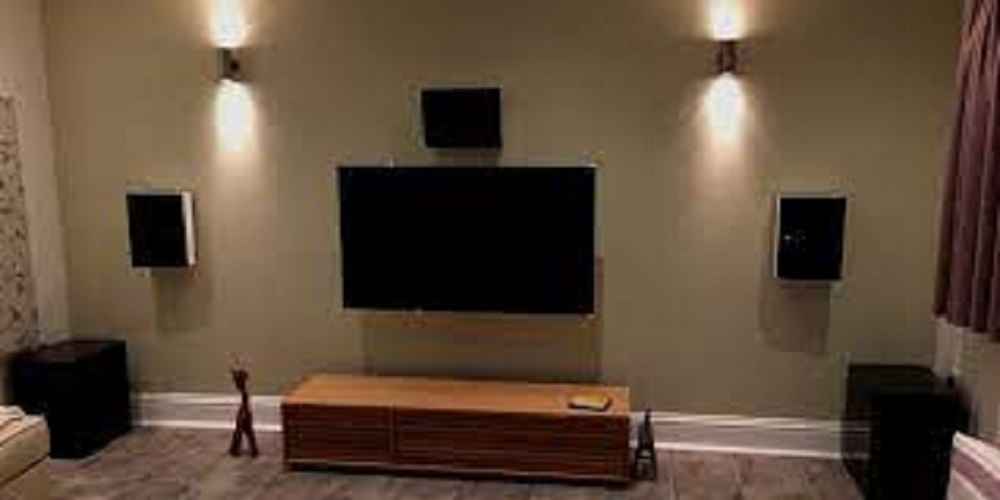Subwoofers are an essential component of a home theater system, providing the deep, powerful bass that gives music, movies, and games an immersive, dynamic quality.
However, a subwoofer adds nothing to the design aesthetic of your living room. Instead, it can sometimes be unsightly or take up valuable floor space, which can detract from the aesthetic of a living room.

The solution to this problem is to hide the subwoofer in your living room. In this article, we will guide you through the steps of hiding your subwoofer in the living room. We will also provide some tips for optimizing your subwoofer’s sound quality.
Understanding Subwoofers
A subwoofer is a speaker that is designed to reproduce low-frequency sounds, typically from 20 Hz to 200 Hz. This is the range of sound that is responsible for the rumble and impact of movies, music, and games.
Subwoofers work by vibrating the air around them, creating sound waves that are transmitted to our ears.
They are usually placed on the floor and use a combination of a large, rigid cone and an amplifier to produce the powerful, deep bass that defines the subwoofer experience.
Factors to Consider Before Hiding a Subwoofer
Before you start the process of hiding your subwoofer, there are a few important factors to consider.
First, you should measure the dimensions of your living room, including the placement of furniture and other items that might impact your ability to hide the subwoofer.
Additionally, you should consider the overall aesthetic of the room, choosing a hiding location that will not detract from the design of the space.

Options for Hiding a Subwoofer
There are several options for hiding a subwoofer in a living room, each with its own advantages and disadvantages.
In-Cabinet Placement
One option is to place the subwoofer inside a cabinet that has a free shelf or compartment. This is the easiest way to hide your subwoofer in your living room.
Don’t hide your subwoofer in a cabinet that has a door, as this will block the front of the subwoofer and negatively affect the sound output and quality of the subwoofer.
Also, choose a cabinet with a compartment that is not much bigger than the subwoofer. This will help to preserve the sound quality of the subwoofer and to cut down on unwanted vibrations and reverberations.
However, if your cabinet has a bigger compartment, you can tuck in some insulation or batting material around the subwoofer to reduce vibrations and reverberations.
Behind Furniture
Another option is to place the subwoofer behind a piece of furniture, such as a sofa or armchair. This is an easy solution that does not require any special modifications or installations.
However, putting your subwoofer behind furniture can negatively impact its sound quality. This is because the furniture may block, absorb, or reflect the sound waves from the subwoofer.
In-Wall or In-Ceiling Installations
Finally, you can install your subwoofer directly in a dedicated wall or ceiling cavity, or by cutting a hole in the drywall and installing the subwoofer into the space.
This is a more permanent solution that can provide the best sound quality, but it is also the most complex of the three options and requires more specialized knowledge and tools.
Step-by-Step Guide for Hiding a Subwoofer
Whether you choose to hide your subwoofer in a cabinet, behind furniture, or in a wall or ceiling, the following steps will help you achieve the best results.
Measure your Dimensions of your Living Room and Furniture Placement
Before you start with hiding your subwoofer, measure the dimensions of your living room, including the placement of furniture and other items that might impact your ability to hide the subwoofer.
You also need to make a sketch of your living room, noting the location of doors, windows, and electrical outlets, as well as the size, shape, and location of any furniture pieces.
Choose the Right Location
Based on the measurements and sketches you have taken in step 1 above, choose a suitable location for your subwoofer that will provide the best sound quality and meet the aesthetic requirements of your living room.
Also, consider factors such as the proximity to walls, the placement of furniture, and the availability of electrical outlets when choosing the right location to hide your subwoofer.
Prepare the Space
Once you have chosen the right location for your subwoofer, then it is time to prepare the space. If you are hiding your subwoofer in a cabinet or behind furniture, make sure that nothing gets in the way of the subwoofer.
If you are installing the subwoofer in a wall or ceiling, use the necessary tools to cut out a suitable space in the wall or ceiling to accommodate your subwoofer. Also, consider how you will handle the wiring connection for the subwoofer when preparing the space.
Install the Subwoofer
After preparing the place to hide your subwoofer, install your subwoofer carefully and securely in the space. Ensure that the subwoofer can’t fall off from the space you are installing it.
If necessary, use studs, clips, or nails to firmly secure the subwoofer to its place. Also, run the wiring connection for the subwoofer.
Test and Tweak the Sound
Finally, test your subwoofer to ensure that it is working properly once the subwoofer is installed. Listen for any rattles, hums, or other sounds that might indicate a problem with the installation.
Adjust the volume and tone settings as necessary to get the best sound quality. If necessary, adjust the placement of the subwoofer if it affects the sound quality or output.
Tips for Optimal Sound Quality
In addition to following the steps outlined above, there are several tips that can help you optimize the sound quality of your subwoofer.
Proper Placement
Ensure that you place the subwoofer in a location that provides the best sound quality. Avoid placing the subwoofer near walls, as this can cause the sound waves to reflect and interfere with each other.
Additionally, ensure that the subwoofer is level and stable, as vibrations can cause the sound to be muffled or distorted.
Adjust the Volume and Tone Settings
Adjust the volume and tone settings of your subwoofer to achieve the best sound quality. Start with the volume set at a moderate level and adjust it until you achieve the desired level of bass.
Then, adjust the tone settings to achieve the optimal balance between the subwoofer and the other speakers in your home theater system.
Calibration
Calibrate your subwoofer using a sound meter or an audio calibration system to ensure that it is producing the correct frequency response.
This will help you achieve the best sound quality and ensure that the subwoofer is working optimally with the rest of your home theater system.

Conclusion
By following this comprehensive guide, you can hide your subwoofer in your living room and still enjoy the best sound quality. This guide will enable you to enjoy the powerful, dynamic sound of your subwoofer without sacrificing the aesthetic of your living room.
Whether you choose to place the subwoofer in a cabinet, behind furniture, or in a wall or ceiling installation, the steps and tips outlined in this guide will help you achieve the best results.
Can I hide the subwoofer in a bookshelf?
Yes, you can hide a subwoofer in a bookshelf as long as the bookshelf has an open compartment to hold the subwoofer.
Simply place the subwoofer in the compartment in the bookshelf and secure it in place with brackets or other mounting hardware. Make sure the subwoofer is level and stable to prevent any vibrations or rattles.
Is it necessary to install the subwoofer in a wall or ceiling?
No, it is not necessary to install a subwoofer in a wall or ceiling. You can also hide a subwoofer in a cabinet, behind furniture, or in any other location that meets the aesthetic and sound quality requirements of your living room.
How do I know if the subwoofer is producing the correct frequency response?
You can use a sound meter or an audio calibration system to measure the frequency response of your subwoofer.
This will help you ensure that the subwoofer is producing the correct frequency response and that it is working optimally with the rest of your home theater system.
Can I use a subwoofer without a home theater system?
Yes, you can use a subwoofer without a home theater system. A subwoofer can be used with any sound system or audio setup to enhance the bass and overall sound quality.
Simply connect the subwoofer to your audio source and adjust the volume and tone settings as necessary.
Is it possible to install the subwoofer in a wall or ceiling if I have no electrical wiring in the wall or ceiling?
Yes, it is possible to install a subwoofer in a wall or ceiling even if there is no electrical wiring in the wall or ceiling. You will need to run electrical wiring from a nearby electrical outlet to the location of the subwoofer.
You can hire an electrician to do this for you if you are not comfortable doing it yourself.
